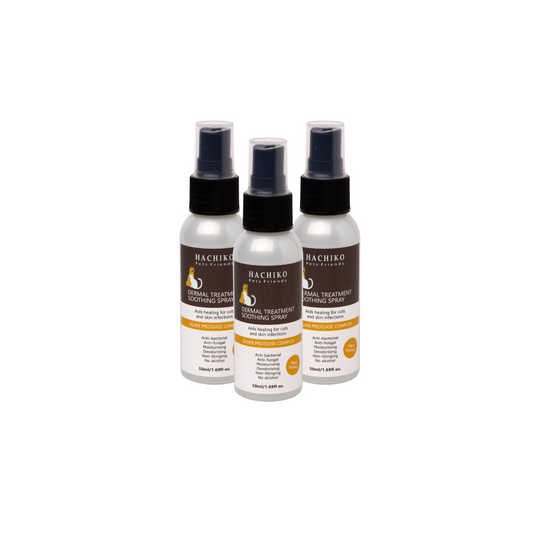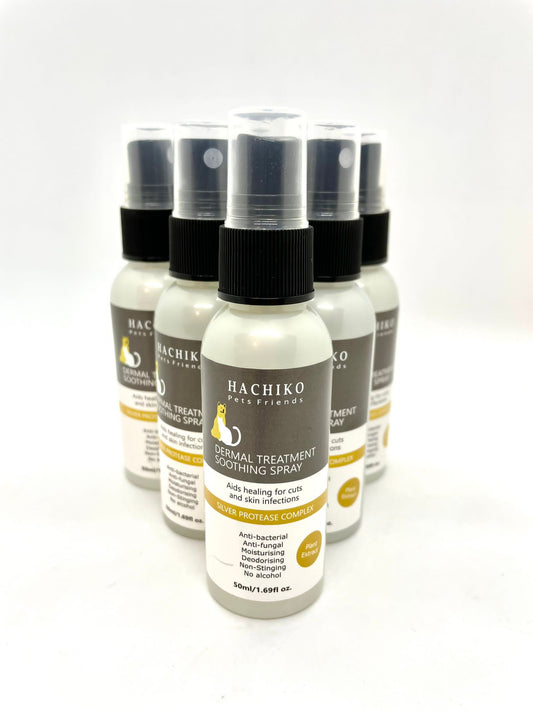
Your Guide to Bacterial and Fungal Skin Infections on Pets
Share
As devoted pet parents, we know that keeping our four-legged family members healthy is always at the top of our to-do list. Whether you have a curious cat, a playful pup, or any other adorable mammalian companion, they're all prone to exploring their world with enthusiasm – and sometimes, that leads to skin troubles. That's where Hachiko's antibacterial and antifungal spray comes to the rescue!
In this guide, we'll dive into the world of pet skin care, exploring how these sprays work their magic, when to use them, and why Hachiko's formula stands out from the pack.
The Science Behind the Spray: How It Works
Ever wondered what makes our spray so effective? It's all about the power trio of ingredients:
- Protease Dextran: Think of this as a microscopic shield. It creates an environment where harmful bacteria simply can't thrive.
- Protease: This enzyme is like a tiny superhero, actively fighting off germs and promoting healing.
- Silver: An age-old remedy with modern scientific backing, silver brings powerful antibacterial properties to the mix.
Together, these ingredients create a formidable defense against a wide range of skin nasties. They work by altering the environment on your pet's skin, making it inhospitable for harmful microbes while supporting your pet's natural healing processes.
Deep Dive: Understanding Bacterial and Fungal Ailments in Pets
As pet parents, it's crucial to understand the various types of bacterial and fungal issues that can affect our furry friends. Let's explore these in detail, focusing on conditions that primarily affect the skin and those that may have skin manifestations as part of a broader health issue.
Primary Skin and Dermal Conditions
These conditions directly affect your pet's skin and are the primary focus of topical treatments like Hachiko's spray:
- Pyoderma
- Definition: A bacterial skin infection
- Subtypes: a) Surface Pyoderma: Affects only the superficial layers of the skin b) Superficial Pyoderma: Involves hair follicles c) Deep Pyoderma: Penetrates deeper layers of the skin
- Symptoms: Redness, pustules, crusting, hair loss
- Acquisition: Often secondary to allergies, skin irritations, or immune system issues
- Seriousness: Can range from mild to severe; if untreated, can lead to deeper skin infections
- Recovery:
- Without treatment: May not resolve on its own, often worsens
- With treatment: Usually improves within 3-4 weeks, but may take longer for deep pyoderma
- Hot Spots (Acute Moist Dermatitis)
- Rapidly developing, localized areas of skin inflammation and bacterial infection
- Often triggered by allergies, insect bites, or excessive licking
- Symptoms: Red, moist, irritated patches that can expand quickly
- Acquisition: Usually triggered by allergies, insect bites, or excessive licking/chewing
- Seriousness: Can rapidly worsen and spread if not addressed promptly
- Recovery:
- Without treatment: May expand quickly, causing significant discomfort
- With treatment: Often show improvement within 3-7 days
- Bacterial Folliculitis
- Infection of the hair follicles
- Often secondary to other conditions like allergies or hormonal imbalances
- Symptoms: Small red bumps, often on the belly or groin area
- Acquisition: Often secondary to allergies, hormonal imbalances, or other skin conditions
- Seriousness: Generally not life-threatening, but can cause discomfort and lead to wider infection if untreated
- Recovery:
- Without treatment: May persist for weeks or months
- With treatment: Usually improves within 3-4 weeks
- Interdigital Furunculosis
- Bacterial infection between the toes
- Common in dogs, especially those with allergies
- Symptoms: Swelling, redness, and sometimes discharge between toes
- Acquisition: Often due to allergies, anatomical factors, or constant licking of paws
- Seriousness: Can cause significant pain and lameness if left untreated
- Recovery:
- Without treatment: Likely to persist or worsen, potentially leading to chronic issues
- With treatment: May take several weeks to months, depending on severity
- Ringworm (Dermatophytosis)
- Despite the name, it's a fungal infection, not a worm
- Caused by various species of fungi, most commonly Microsporum canis
- Subtypes based on causative agent: a) Microsporum canis: Most common in cats, can spread to dogs and humans b) Microsporum gypseum: Often contracted from contaminated soil c) Trichophyton mentagrophytes: Can affect various animals, including rodents
- Symptoms: Circular patches of hair loss, sometimes with scaling or crusting
- Acquisition: Highly contagious, spread through direct contact or contaminated objects
- Seriousness: While not usually dangerous, it's a public health concern as it can spread to humans
- Recovery:
- Without treatment: May resolve in 3-5 months in healthy pets, but remains contagious
- With treatment: Usually clears up in 6-8 weeks with proper treatment
- Malassezia Dermatitis
- Overgrowth of naturally occurring yeast on the skin
- Often secondary to other conditions like allergies or hormonal imbalances
- Common in certain dog breeds with skin folds
- Symptoms: Itching, redness, greasy or scaly skin, sometimes with a distinct odor
- Acquisition: Overgrowth of naturally occurring yeast, often due to underlying conditions
- Seriousness: Not life-threatening, but can cause significant discomfort and skin damage if untreated
- Recovery:
- Without treatment: Unlikely to resolve without addressing underlying causes
- With treatment: Often improves within 2-4 weeks, but may require ongoing management
Conditions Affecting Skin and Nearby Structures
These issues primarily involve the skin but may also affect adjacent areas:
- Otitis Externa
- Definition: Bacterial infection of the outer ear canal
- Often accompanied by yeast overgrowth
- Symptoms: Ear scratching, head shaking, foul odor from ears
- Acquisition: Often due to moisture trapped in ears, allergies, or anatomical factors
- Seriousness: If untreated, can lead to chronic ear problems, hearing loss, or deeper infections
- Recovery:
- Without treatment: Unlikely to resolve on its own, often becomes chronic
- With treatment: Most cases improve within 1-2 weeks
- Sporotrichosis
- Rare fungal infection caused by Sporothrix schenckii
- Can be contracted through cuts or scratches, often from plant material
- Symptoms: Small, hard bumps that can develop into open sores
- Acquisition: Usually through cuts or punctures, often from plant material
- Seriousness: Can spread to lymph nodes and internal organs if left untreated
- Recovery:
- Without treatment: Unlikely to resolve on its own, can become systemic
- With treatment: Usually requires several months of treatment
Systemic Infections with Potential Skin Manifestations
These are more serious conditions that can affect multiple body systems but may show symptoms on the skin:
- Cryptococcosis
- Systemic fungal infection that can affect the skin
- More common in cats than dogs
- Often starts in the nasal passages and can spread to the skin and other organs
- Symptoms: Skin lesions, particularly on the face and neck
- Acquisition: Usually inhaled from the environment, particularly areas with bird droppings
- Seriousness: Can be life-threatening if it spreads to the central nervous system
- Recovery:
- Without treatment: Potentially fatal if it becomes systemic
- With treatment: May require several months to a year of antifungal therapy
- Blastomycosis
- Systemic fungal infection that can have skin manifestations
- More common in dogs than cats
- Often contracted by inhaling fungal spores from soil
- Symptoms: Skin lesions, often draining tracts, along with respiratory symptoms
- Acquisition: Usually inhaled from contaminated soil
- Seriousness: Can be life-threatening, especially if it spreads to lungs or other organs
- Recovery:
- Without treatment: Often fatal if left untreated
- With treatment: Usually requires 6-12 months of antifungal therapy
Why Choose Hachiko?
In a market full of options, Hachiko's Antibacterial and Antifungal Spray stands out:
- Fast-acting formula: Our unique blend of ingredients gets to work quickly to provide relief.
- Gentle on skin: Safe for regular use without causing irritation.
- Versatile: Effective for a wide range of pets, from dogs and cats to smaller mammalian companions.
- Natural ingredients: We harness the power of nature, avoiding harsh chemicals.
When to Seek Professional Help
While our spray is effective for many common skin issues, there are times when a visit to the vet is necessary. If you notice:
- No improvement after a week of treatment
- Worsening of the condition
- Signs of discomfort or distress in your pet
It's time to seek professional advice. Your vet may recommend additional treatments or perform tests to get to the root of the problem.
A Promise of Care: The Hachiko Difference
Just as the loyal Hachiko waited faithfully for his owner, our team at Hachiko is dedicated to standing by you and your pet through every scratch, itch, and snuggle. Our antibacterial and antifungal spray is more than just a product – it's a promise of care, crafted with the same devotion you show your furry family members every day.
Don't let skin issues come between you and your pet's cuddle time. With Hachiko's spray, you're equipped to tackle common skin problems head-on, keeping your pet's coat healthy, shiny, and irresistibly pettable.
Ready to give your pet the Hachiko healing touch?



